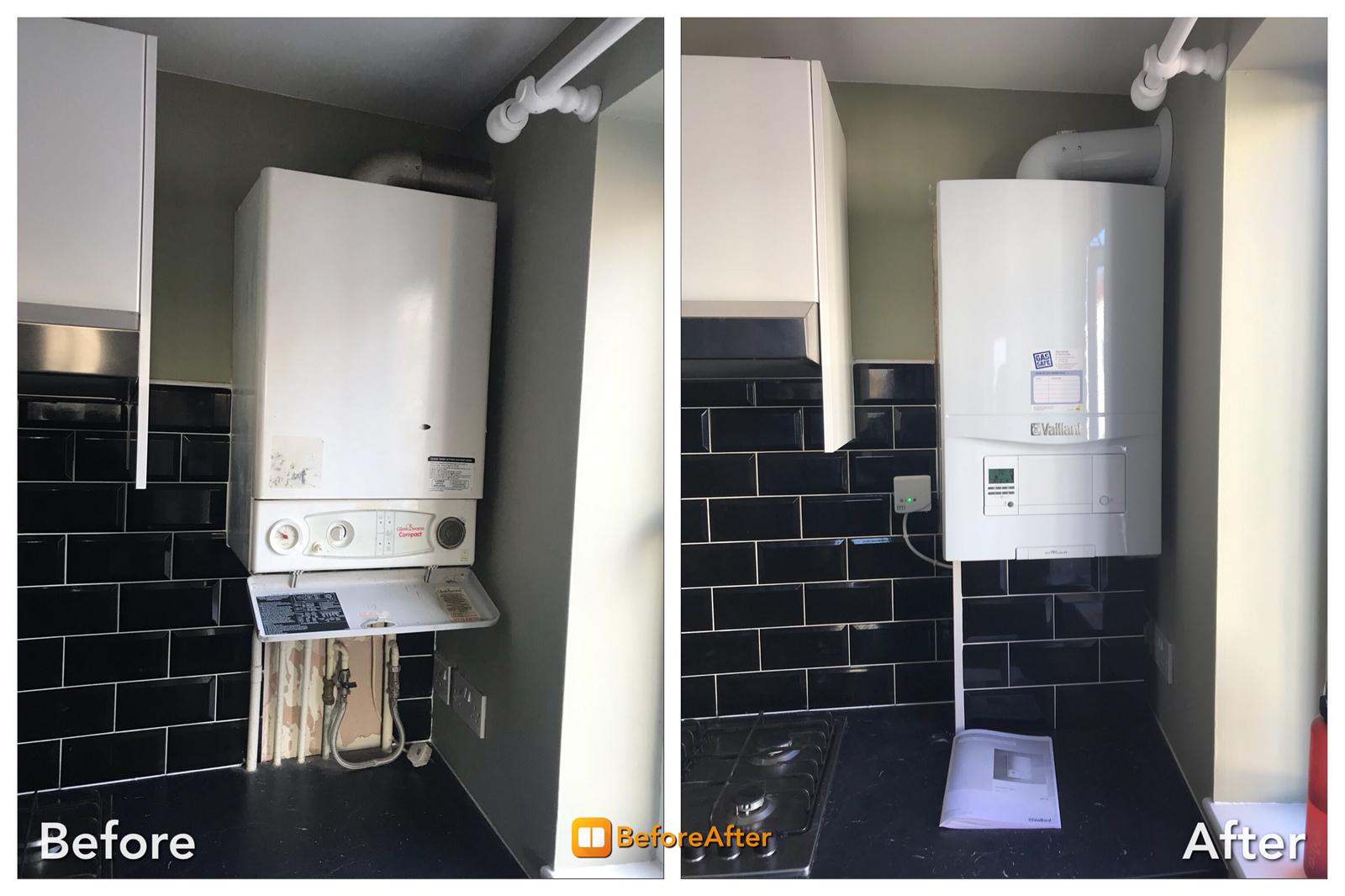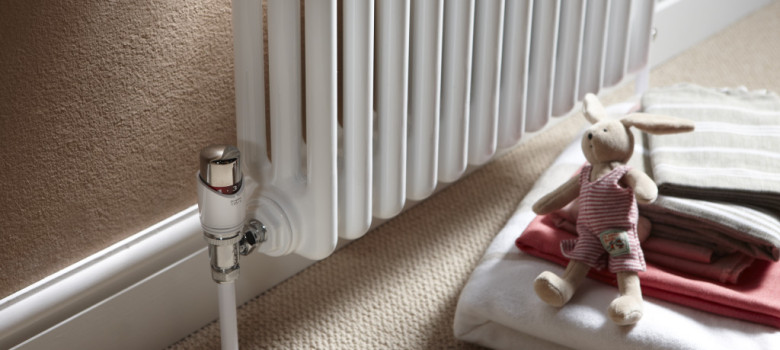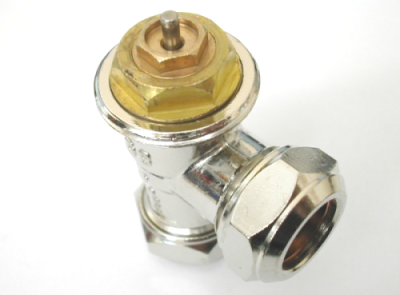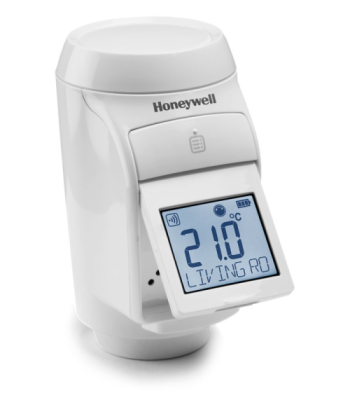May 19, 2022 in Uncategorized
Apprenticeship Awards Finalists

May 19, 2022 in Uncategorized

September 6, 2019 in New Boiler
All Our engineers are highly trained and Gas Safe Registered. The picture attached is from one of our recent Gas Combination (Combi) boiler replacements. As you can see the new Vaillant gas boiler looks more modern than the old one adding to the modern look of the kitchen.
Our client was very happy with work carried out and the improvement of hot water pressure the new Vaillant gas boiler has given them.
This job was completed in just one day and the system was Chemically Power Flushed. Our gas safe registered engineer removed the old boiler from the property along with all the packaging from the new gas boiler. Inhibitor was added to the system water to help prevent corrosion inside the pipework, boiler and radiators.
Additionally, new thermostatic radiator valves were installed to the radiators to help control the temperature in each room. A programmable room thermostat was installed in the hallway to help prevent the house from over heating. All controls were shown and demonstrated to our client so they know how it use them.
This boiler comes with a 7 year warranty that covers parts and labour.

September 6, 2018 in Servicing
Having your Gas boiler serviced annually is essential to guaranty the safe and efficient operation of your appliance. Your boilers warranty may also be void if the appliance is not serviced each year. Here at Gas Safe our engineers are trained to maintain all different makes of boiler. Valliant, Worcester, Baxi, Ideal, Potterton, Viessmann, Vokera, Glow-worm – are all makes of boiler we work on.
August 16, 2018 in Combi Boiler
A combination boiler or combi boiler is a gas central heating boiler that is also an instantaneous water heater. A combi boiler is an ingenious space-saving idea, and an increasingly popular choice in UK homes. In fact, combi boilers now account for well over half of all the new domestic boilers installed in Britain every year.
A combi boiler is both a high-efficiency water heater and a central heating boiler, combined (hence the name) within one compact unit. Therefore, no separate hot water cylinder is required, offering space saving within the property.
Further benefits of a combi boiler includes hot water being delivered through your taps or shower at mains pressure. So you can enjoy powerful showering* without the need for a pump.
Another combi boiler benefit is that it can generally save you money on installation time and costs, since no tank in the roof space means less pipe work and a shorter installation time.
A Combi boilers works the same as a standard boiler by burning gas and producing heat. This heat is then used to warm the water passing through the boiler using a heat exchanger. With a standard boiler that water would then flow through your radiators or hot-water cylinder. A Combi boiler works differently by having a second heat exchanger that transfers heat from the main heat exchanager to the mains cold water passing through the boiler when a hot tap is tuned on.
Make sure you have an adequate supply of water coming from the mains. If the mains pressure is weak or inconsistent, your showers and taps will be too. This single flow of water is also a problem if you have several showers, baths and sinks that need to be used simultaneously as the flow will try to split between them all and weaken as a result.
If you have a higher demand for hot water then a high efficiency, condensing system or conventional boiler may be the answer.
All condensing boilers require a condensing pipe to drain the condensed vapour and dispose of it down a drain. If the installer can’t add a pipe where the existing boiler is positioned then it may need to be relocated; this may add to the cost of installation.
The main manufactures of combi boilers in order of our own recommendation are:
Despite the popularity of combi boilers, there are several issues that you should bear in mind when considering replacing your boiler.
The disadvantages of combi boilers include:
At Gas Safe Bristol, we provide a complete combi boiler service including installation, emergency repairs and servicing. If you need a combi boiler installed, or aren’t sure which boiler to go for, we can help. Call one of our team today on 0117 964 0078 or fill out a contact form and we’ll get back to you.
August 9, 2018 in New Boiler
Buying a new boiler tends to be a decision that most people need to make in a hurry. Usually, your old boiler has broken down, it’s the depths of winter and you need to get your hot water and central heating restored to its former working glory.
August 9, 2018 in Landlords, Safety
As a landlord you should be aware that you are responsible for the safety of your tenants. Your legal duties apply to a wide range of accommodation occupied under a lease or licence, including (but not limited to):
The Gas Safety (Installation and Use) Regulations 1998 outline the duties of landlords to ensure gas appliances, fittings and chimneys/flues provided for tenants are safe.
August 9, 2018 in Uncategorized

Thermostatic radiator valves are commonly referred to as TRVs and are used to control the air temperature of different rooms – you will normally find them on the side of your radiators.
TRVs are just one of a number of heating controls, which allow homeowners to heat their homes more efficiently. If set up correctly, they allow you to have different heating zones throughout the house, despite only one centralised boiler providing the heat.
The TRV is a self-regulating valve that works by changing the flow of hot water into a radiator. It consists of two parts, the valve head and the valve body, with the head sitting atop the body.  When the room temperature changes, a capsule in the valve head contracts or expands, which moves a pin in the valve body causing it either to open or close.
When the room temperature changes, a capsule in the valve head contracts or expands, which moves a pin in the valve body causing it either to open or close.
If it gets too warm in the room, expansion of the capsule will cause the pin to close the valve – slowing the movement of hot water into the radiator. Likewise, if the room drops in temperature, contraction of the capsule in the valve head pulls the pin out, allowing hot water to enter the radiator once more.
There tends to be two materials used in the TRV capsules – wax or liquid. On the whole, liquid models are generally considered to be better and their price reflects this. One of their advantages is their responsiveness to changes in temperature – while the wax one is relatively slow to expand or contract, the liquid capsule will change the flow of water into the radiator far more quickly.
A TRV will cost you about £10 – 30 each. The Drayton TRV4 for example, which is a liquid capsule TRV and is considered one of the best costs £20 from Screwfix. Installation cost will very depending the system. A full drain down is usually needed and can take some time. Inhibitor is then needed when filling the system back up.
There are two places that you really shouldn’t install TRVs on the radiators – the first is in bathrooms. This is because the heat produced by the bath/shower will cause the TRV to shut off (it will cause the capsule to expand), just when you need the heat from the radiator to fight off condensation.
We also don’t advise installing a TRV in the same room as your main heating thermostat. The main thermostat will link directly to the boiler, firing it up or turning it down, so by having a TRV in that room they will fight for control – if the TRV wins, the heating in your house will go off!
 Nowadays you can take zonal heating control a step further with electronic TRVs (for example Honeywell’s Evohome system). These electronic TRVs use batteries and electronic thermostats to constantly monitor the temperature of the room and move the pin up and down accordingly.
Nowadays you can take zonal heating control a step further with electronic TRVs (for example Honeywell’s Evohome system). These electronic TRVs use batteries and electronic thermostats to constantly monitor the temperature of the room and move the pin up and down accordingly.
They can also be used with the other heating control components to create an intelligent heating system like the Heat Genius system. This obviously adds significant cost to the system, but allows you to accurately monitor and control the temperature of individual rooms in the home all from the touch of the button on your tablet computer or phone.
In properties with a decent number of different rooms, then TRVs are definitely worth considering, especially if there are rooms that are unused and therefore not worth heating in the first instance.
They can produce decent energy savings especially when part of an intelligent heating system.
It is important to maintain them though; many clients we see have non-functioning TRVs.
It is important to ensure that the valve head vents don’t get clogged by dust and other objects since this can obstruct air hitting the liquid or wax capsules that control how the TRV functions. It is also worth checking once a year that the pin in the valve body is still moving freely (these sometimes get stuck).
To do this, unscrew the valve head off the body – this should reveal the pin that moves up and down controlling the flow of water into the radiator. A spring should hold the pin fully extended above the valve – if the pin doesn’t move when you push it, you may need to replace the whole valve assembly.
August 9, 2018 in Hints & Tips
The average household spends more than £1,200 a year on energy bills – nearly half of which goes to heating. Homeowners can save about £120 a year by properly setting their programmable thermostats and maintaining those settings
A programmable thermostat helps make it easy for you to save by offering four pre-programmed settings to regulate your home’s temperature in both summer and winter – when you are home, asleep, or away.
August 3, 2018 in Company News
Our advert was recently featured in ‘What’s On Bristol’, a popular magazine read by 1000s of Bristolians. Check out the advert here.
August 3, 2018 in Company News - 1
A family owned and run business that has been servicing Bristol and the South West for the last 15 years.